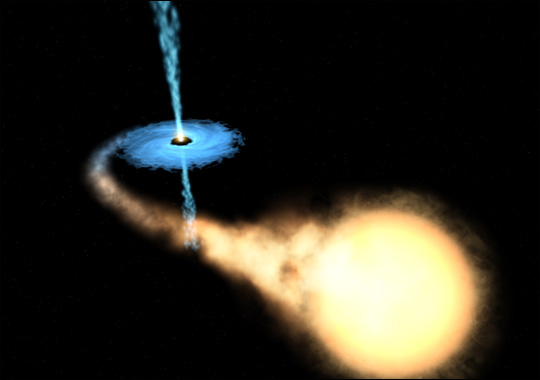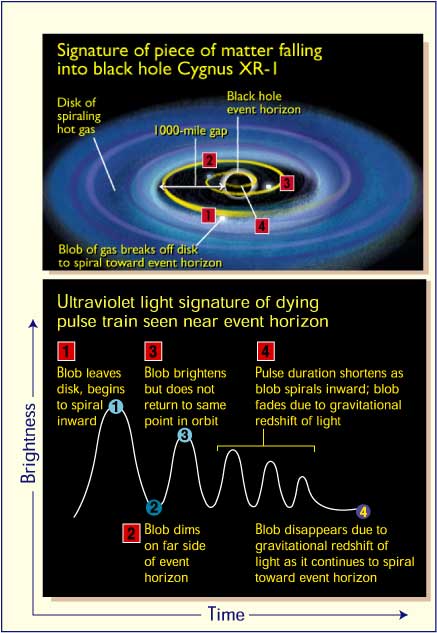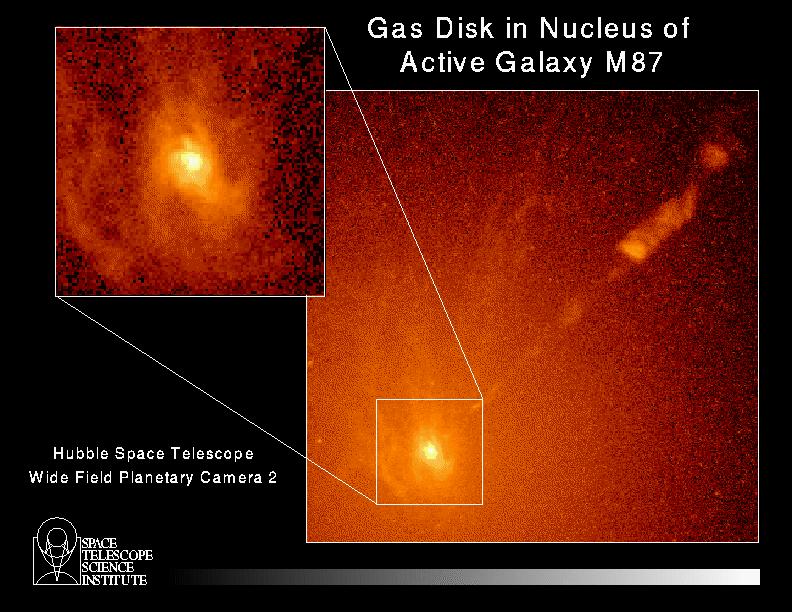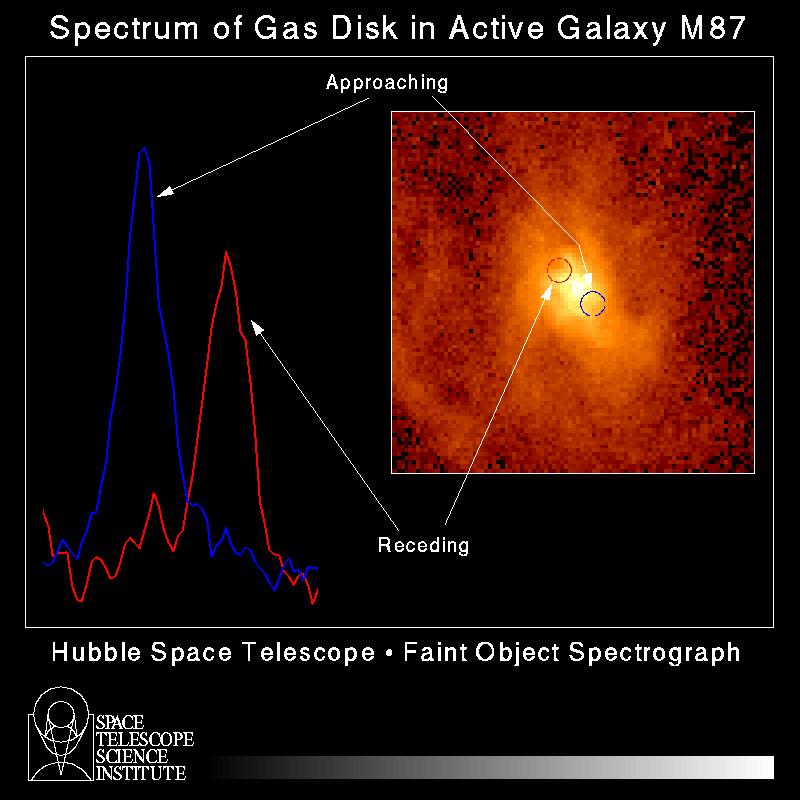
(presentation for Powell Observatory Open House, October 8, 2005)
The short answer to the question is, "Likely." That means that most astronomers and physicists have good theoretical reasoning to believe that black holes can exist. The problem is that by their very nature, black holes are ... well, they are black. As we shall see below, this is not entirely true; however, for all intents and purposes, evidence for the existence of black holes in the universe is fundamentally of an indirect nature, coming from how black holes influence their surroundings.
Before going further, we first must determine what a black hole is and is not. Black holes do have mass. In fact, it is because they have mass that they can become black holes. So black holes have gravity. But black holes are not cosmic vacuum cleaners. It is true that anything entering a black hole cannot re-emerge again; however, it is not true that black holes are sucking in matter from all over the universe, causing everything to fall into them.
For example, if the Sun were replaced by a black hole of the same mass as our Sun, then it turns out that the Earth's orbit would be largely unchanged (only our planet would become very cold!).
The details of how black holes are made are not terribly important to this discussion. What is key is the following idea. Gravity is an attractive force, and only an attractive force. So all bits of mass everywhere are tugging on everything all at once, tugging harder are nearer objects and weaker on the more distant ones. When mass becomes concentrated in a local volume of space, such as the gas in a star, gravity wants to make of that matter come crashing, and crushingly, together. What prevents this from happening? The answer is gas pressure. There is high pressure in the center of this volume of mass, while space itself is a near vacuum, so that there is a huge pressure difference between the gas at the star's center and its outer portion, and this pressure difference resists the tendency of gravity to further compress the gas.
Nice. But to make a long story short, it turns out that when there is enough concentration of mass in the volume, there is no kind of gas pressure that is capable of preventing the crushing effects of gravity, so that all of that mass squeezes together, essentially to a point of matter, a point with small or zero volume but finite mass, and so having essentially infinite density! This is a black hole.
An important concept in gravity is that of escape speed. This is the speed necessary for something to move away from a body of mass and never quite fall back. Moving faster than escape speeds ensures that it won't fall back. Moving slower, and the object will execute some form of orbit around the body (possibly only to hit the "ground", or surface of body).
The laws of physics and experimental confirmation indicate that nothing travels faster than the speed of light. Objects with higher and higher masses have larger and larger escape speeds, and there is no limit to this. Black holes, having infinite density, have an infinitely large escape speed. But it turns out that the escape speed value depends on how far an object is from a body of mass. So there is a certain distance from a black hole where the escape speed just equals the speed of light. This is usually represented by a sphere or globe called the "Event Horizon", with a spherical radius given by the Schwarzschild radius which depends on the mass of the black hole. Inside the event horizon, the escape speed is larger than the speed of light, and so nothing can get out if anything ventures this close. Outside the horizon, light that passes by can escape, although it will not travel in a straight line. This means light going into the event horizon (and anything else!) cannot get out, and so that region is necessarily black.
Disturbingly, black holes practice cosmic censorship. There is no telling what happens on the inside. You could go in to look for yourself (but of course you would die), but there would be no way to tell your friends because you could not get back out. Weird.
Although black holes do not glow, they do have gravity, and so they affect (sometimes drastically) their neighborhood, and we can infer the presence of a black in this way. This is of course indirect, which is not as nice as just seeing the black hole itself, and so can be suspect for the skeptical observer. Yet, it turns out that we often cannot understand what we see from the neighborhood unless a black hole is present, and sometimes this argument can be especially strong when the properties of the neighborhood conform to predictions for how a black hole will affect it.
The theory of stars would claim that massive stars (much more massive than the Sun) will eventually blow up as supernovae, and if there remains a core in excess of around 3 times the Sun's mass, that will collapse under gravity to become a black hole. If this happens in a binary star system, in which one star makes a black hole and the other star manages to survive so that the two continue orbiting one another, then the normal star can in some cases transfer gaseous matter to the black hole (see figure below). As this gas fall toward the black hole, it makes a disk of orbiting gas that slowly dribbles into the black hole. In this process the gas is heated and manages to glow in X-rays. So we cannot see the black hole, but we do see intensely bright X-rays. We also see the one star and can infer the presence of an unseen companion. All of this seems to add up to a black hole.

An especially famous case is the system Cygnus-X1, a binary that has a "missing" companion (we do not see it) but glows brightly in X-rays. The neat thing is that the Hubble Space Telescope has been able to watch as matter dribbles into the black hole. For any normal body, the infalling of gas would cause it to glow more brightly. But because of the odd properties of black holes, such gas as it approaches the event horizon will inevitably grow fainter, and this is what is observed (see figure below).

Another place to find black holes - supermassive ones - seems to be in the heart of galaxies. These monsters are can have anywhere from millions to billions of times the mass of the Sun. The event horizons can be about as large as our solar system. Below are some Hubble images pertaining to a suspected black hole in the heart of the giant galaxy M87. The first image shows the center of the galaxy, and that a jet leads back to its center. The inset of that figure indicates a swirling disk of orbiting gas near the center. The figure below shows how the Hubble can measure the speed of orbiting gas in this disk. It turns out that as these distances from the center (light years), the speeds are so high (hundreds of kilometers per second), that a tremendous amount of mass must exist interior to the disk, a mass of about 100 million Suns, but in a volume that is like the distance from the Sun to the nearest star. The implication of a black hole is based on the idea that it is gravity which makes the gas orbit, and stronger gravity leads to higher speeds. Except for a black hole, no one knows how to cram so much matter into so little volume.


Here is a short 'movie' visualization of a supermassive black hole at the center of a galaxy.
You have probably heard of a clever fellow named Stephen Hawking. One of the fundamental challenges facing physicists today is a theory that makes connections between our understanding of gravity and our understanding of quantum phenomena. One of the steps in that direction was a realization made by Hawking that allows black holes to glow, in a sense. This is best described with an example. Quantum theory allows for particles and their anti-particles to briefly come into existence, and then "annihilate" each other. They come, they go, and no one knows the better. However, if this should occur near a black hole, it may be that one particle falls into the black, while the other moves away. The escaping is made real, with real energy, so to conserve energy, the particle falling into the black hole must count as a debit. (This sounds disturbingly like my cheque book: money goes out, and my bank account takes a hit!). But energy is mass (so says Einstein), and so the energy debit amounts to a small loss of mass. This idea is now known as Hawking radiation, and the result is that black holes can evaporate. It happens that the evaporation becomes more rapid for black holes of less mass. The trend is for black holes to loss mass increasingly faster with time. Still, for the kinds of black holes discussed here, the process is very very long. Still physicists hope one day to create "mini-black holes" that will live for only a short time, so as to test the theory of Hawking radiation.